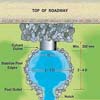| . |  |
. |
New Orleans, Louisiana (AFP) Oct 12, 2005 The final portion of storm-savaged New Orleans was open to residents on Wednesday, with road blocks lifted at a neighborhood nearly obliterated during hurricanes Katrina and Rita. Cars and trucks backed up for blocks through the day as people waited to pass a military checkpoint and cross a drawbridge that served as the sole access route to what was left of the twice-flooded Lower Ninth Ward. Returning refugees were greeted by the remnants of homes and businesses, toppled trees, snapped utility poles and trashed vehicles. Police and Army National Guard troops patrolled the tattered streets and prevented people from getting to the wiped out zone close to where a levee broke in two places during the storms. Sheila Craig and her two grandchildren walked slowly along a road near what was left of her house, calling the name of her Labrador retriever, Chip. "I was in the storm, me and my two dogs, Chip and Sugar, when the boat came and got me," the 47-year-old woman recounted. "That's how we got separated." Craig told of the flood waters engulfing her house, and of seeing a barge pass by her front door before she was rescued. Sugar was found. Chip was still missing. "Ain't nothing to stay for; my house is a wreck," Craig said. "I just came back here to see what I could see and see if my dog was still alive." Mayor Ray Nagin cleared the way for displaced residents to return to the Lower Ninth Ward on Wednesday for the first time since storms and flooding laid waste to the working-class neighborhood. "It is important for people to see their homes and move forward with the process of building a new future for their families," Nagin said in a statement. "Since the area sustained heavy damage, we urge everyone to take the necessary precautions to remain safe as they return." Phased returns to New Orleans began on September 30, with people allowed to check on their homes and businesses in the French Quarter and other less-damaged parts of the city. Residents who venture back into the Lower Ninth were asked to "look and leave," lingering only long enough to survey their properties and salvage whatever belongings possible. Sisters Aminisha and Rashida Ferdinand drove from Atlanta, Georgia, to check on their homes in the neighborhood where their family had lived for generations. "It felt strange seeing the city, but it felt good," Aminisha Ferdinand said after hugging neighbors she hadn't seen since fleeing an approaching Hurricane Katrina. Rashida, a sculptor, found the corrugated metal roof ripped off her workshop in a buckboard barn behind her house. Sunlight blazing in through the missing roof reflected off her artwork, hanging clay eyes adorned with bits of mirror. Spots of light danced on a barn wall. "I'm going to cry, that's so beautiful," Aminisha said as a neighbor dubbed one of the orbs an "eye of the hurricane." Inside the house, furniture was overturned in dried mud, flooring was missing and black mold grew on walls. "It could have been worse," Rashida concluded before she and her sister went to get cleaning supplies at a Red Cross station in the neighborhood. Aminisha was outraged by the memory of how the neighborhood was blasted twice: submerged after Hurricane Katrina broke a levee only to be flooded again when Hurricane Rita overwhelmed the patched-up canal wall. The canal levee lining the neighborhood broke in two places during the hurricanes, and flood water washed away blocks of homes. A barge that came in with the water remained atop houses and a public school bus. Aminisha dismissed speculation about razing the devastated Lower Ninth Ward, saying there were too many salvageable homes to give up on the area. "I want to make sure I buy property here before random developers come in and buy it and have no connection to the community and build ugly, regular copycat houses," Aminisha said. Visitation hours were set at 8:00 am to 6:00 pm daily. The Army Corps of Engineers reported Wednesday it had pumped out the last of the flood water but was still working on temporary repairs to the breaches in the levee. Residents who return to the neighborhood were advised to wear gloves, boots and coveralls, as well as breathing masks to protect from dust, mold and other airborne contaminants. Residents were also advised to get tetanus shots and watch out for animals, domestic and wild, that might be dangerously hungry or disoriented from weeks spent surviving in the desolate area. "We're going to make it," Sheila Pichon, a breathing mask dangling from her neck, said as she stood in the bed of a pickup truck outside the house she and her husband lived in for 33 years. "We're just going to have to start all over again." Related Links SpaceDaily Search SpaceDaily Subscribe To SpaceDaily Express  Keene NH (SPX) Oct 12, 2005
Keene NH (SPX) Oct 12, 2005The storm that dropped over 10 inches of rain on the Keene, NH area this past weekend will be a more frequent phenomenon due to climate change, according to two New Hampshire researchers. |
|
| The content herein, unless otherwise known to be public domain, are Copyright 1995-2006 - SpaceDaily.AFP and UPI Wire Stories are copyright Agence France-Presse and United Press International. ESA PortalReports are copyright European Space Agency. All NASA sourced material is public domain. Additionalcopyrights may apply in whole or part to other bona fide parties. Advertising does not imply endorsement,agreement or approval of any opinions, statements or information provided by SpaceDaily on any Web page published or hosted by SpaceDaily. Privacy Statement |